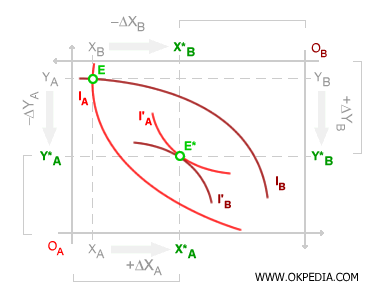Pareto optimality
Pareto optimality (also known as Pareto efficiency) describes a situation in which resources are allocated in the most efficient way possible. In a Pareto optimal state, it is impossible to improve one person's welfare (or utility) without reducing the welfare of others. This concept, named after the Italian economist Vilfredo Pareto, serves as a fundamental measure of efficiency in economics.
For instance, in an economy with two consumers, an equilibrium is Pareto optimal if it's impossible to increase one consumer's utility by changing their choices without decreasing the utility of the other.
In an Edgeworth box, Pareto optimality occurs at a contract point, where the two consumers' sets of indifference curves are tangent. In the diagram below, point E is not Pareto optimal, while point E* is.

In political economy, a Pareto-efficient allocation is the best possible outcome in terms of both allocative and productive efficiency. A Pareto optimal point represents the peak of economic improvement. At this point, it is impossible to enhance one individual's situation without negatively impacting another. If it were possible, it would imply that some people's situations could be improved without worsening others', leading to a Pareto efficiency improvement.
 Interpersonal utility. The criterion of Pareto efficiency allows us to identify an efficient social optimum for resource allocation without the need to compare individuals' utilities. This approach helps Pareto avoid one of the key criticisms of utilitarianism.
Interpersonal utility. The criterion of Pareto efficiency allows us to identify an efficient social optimum for resource allocation without the need to compare individuals' utilities. This approach helps Pareto avoid one of the key criticisms of utilitarianism.
 Equity. While Pareto optimality assesses economic efficiency in equilibrium, it does not address equity. Efficiency is independent of fairness, meaning it doesn’t judge whether one equilibrium is more or less fair than another. A Pareto optimal outcome can exist in both equitable and inequitable distributions of income and wealth. This is one of the main limitations of using Pareto optimality as a tool for evaluating social welfare in economic policy. For example, a redistribution of income from wealthier individuals to poorer ones, even if it leads to greater social equity, would not be considered a Pareto improvement because the wealthier group would be worse off.
Equity. While Pareto optimality assesses economic efficiency in equilibrium, it does not address equity. Efficiency is independent of fairness, meaning it doesn’t judge whether one equilibrium is more or less fair than another. A Pareto optimal outcome can exist in both equitable and inequitable distributions of income and wealth. This is one of the main limitations of using Pareto optimality as a tool for evaluating social welfare in economic policy. For example, a redistribution of income from wealthier individuals to poorer ones, even if it leads to greater social equity, would not be considered a Pareto improvement because the wealthier group would be worse off.
 Walrasian equilibrium. According to the welfare theorems, if indifference curves and isoquants are convex, every Pareto-efficient allocation (Pareto optimum) has a corresponding set of prices that can sustain a Walrasian equilibrium in both exchange and production.
Walrasian equilibrium. According to the welfare theorems, if indifference curves and isoquants are convex, every Pareto-efficient allocation (Pareto optimum) has a corresponding set of prices that can sustain a Walrasian equilibrium in both exchange and production.
